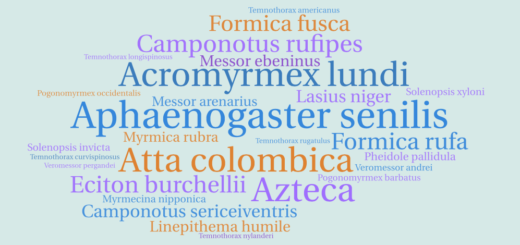Ant abundance, biomass, and distribution

In the paper “The abundance, biomass, and distribution of ants on Earth” published in PNAS, Patrick Schultheiss, Sabine S. Nooten, Runxi Wang, Mark K. L. Wong, François Brassard, and Benoit Guénard analyse the gathered information on both ground-dwelling and arboreal ants to generate an empirical estimate of the global ant abundance. Understanding the distribution and abundance of species is essential to understand their ecological significance for other taxa as well as their roles within ecosystems. They also conservatively estimate the number of all ants on Earth but read on for the number. Overall, this study highlights the crucial function that ants perform in terrestrial ecosystems while also pointing up significant ecological and spatial knowledge gaps. Here, the authors answer a few questions and highlight the main points of their work.
An Interview compiled by Phil Hoenle, Patrick Krapf, and Beatriz Porthina
Featured image “Eciton bruchellii parvispinum taking apart an insect larva” by Phil Hoenle

MNB: Could you tell us a bit about yourself?
SN: I am an insect ecologist, and I am passionate about finding out why organisms live where they live and how they are connected to their environment. Growing up with plenty of access to nature, I quickly became interested in the plants and animals around me. Being a traveler by heart and awed by the diversity of ecosystems on Earth, I pursued my work across four continents – Australia, North America, Southeast Asia and Europe. My work investigates how species traits are influenced by the environment and which traits are needed to persist under rapid environmental change. So far, I have pursued this line of work in a variety of habitats, ranging from dry to wet forests, and from native to managed ecosystems – and I am planning to explore more.
PS: I have long been intrigued by nature and its intrinsic beauty, but it wasn’t until 2008 (when I started my PhD) that I became fascinated by ant biology, ecology, and biogeography. I am particularly interested in their behaviour, and I am using an integrative, interdisciplinary approach to gain a mechanistic understanding of behavioural processes. I have been fortunate to be able to combine my scientific pursuits with my love of traveling, and have been living and working across several different countries and continents.
FB: I am and have been fascinated by insects since childhood. I am now mainly interested in ant ecology, biogeography, evolution and taxonomy. My M. Sc. Project focused on the biogeography of morphological traits in North American Formica ants. I then worked at the University of Hong Kong, where I documented the ant biodiversity of Macao SAR, China. I am now doing my PhD, which focuses on the effects of fire and aridity on the ants of Australian savannas. I am also an avid macrophotographer. Through photography, I aim to showcase the strange beauty of the critters that inhabit our world. In doing so, I hope to promote their importance and conservation to the general public and inspire a new generation to pursue entomology.
RW: I have been attracted by biodiversity since I was young and have always been interested in how many species there are and where they are distributed. I’m currently working on the ecology and biogeography of insects and plants, trying to understand their distributions and dynamics based on biological and environmental datasets, and computer science. I believe that ecological observation and modeling are powerful tools to help us see, feel and coexist with nature and other creatures.
MW: I am captivated by the tremendous diversity of ant forms and the thrilling prospect that novel species and fascinating interactions are often just under that stubborn rock, behind that juicy piece of bark, or in that twig beyond reach. I have a big appetite for research on community processes, traits, field experiments and mesocosms. I believe that there are tons of good stuff underground, awaiting discovery. To me, subterranean pitfalls and soil extraction are the way to go. Currently, my favourite ants are those of the Gesomyrmex genus, and I want to see ants of the Opamyrma genus.
BG: Fascinated by nature, and insects especially, since my childhood, I had the opportunity to work with ants since my time in Canada in the early 2000’s, and never stopped since through a journey that led me to the USA, Japan and Hong Kong among other places. My research focuses mainly on ant ecology, biogeography and taxonomy, with projects using various spatial and temporal scales to describe and understand the patterns that we observe today, including through anthropogenic changes.
MNB: Could you briefly outline the research you recently published in layman’s terms?
Team: We are increasingly aware that ants are key ecological players in many ecosystems. This is due to their incredible taxonomic diversity and the accompanying diversity in ecological roles, but also owing to their generally high abundance. Our study provides the first global overview of ant abundance patterns – the typical density of ground-dwelling ants in different biomes and habitats. We scoured the scientific literature for published values on ant abundance from all over the world and were able to compile data from over 450 different studies. Our final dataset comprises values from over 1000 different locations on Earth, which have been collected by many different ant researchers over the last eight decades. We found that, on a global scale, ant abundance is highest in tropical biomes – which is particularly intriguing as we already know that these areas have the highest ant diversity as well, potentially suggesting that similar factors may be driving species richness and abundance. In terms of the local environment – the habitat – ants are particularly abundant within forests, where, for instance, they can be six times more numerous than in shrubland.
In addition, we were able to provide an empirical estimate of the total number of ants on Earth, which we calculate to be 20×1015 individuals (that’s a 20 with 15 zeros). We estimate that this represents a dry carbon biomass of 12 megatonnes, which corresponds to about 20% of the global human biomass, and actually exceeds the combined biomass of all wild birds and wild mammals.
MNB: What is the take-home message of your work?
Team: For the first time, we have a global picture of the biogeography of ant abundance, and find that certain parts of the world host many more ants than others. Our estimates of the global ant population and biomass also provide a sense of scale, which can help us in evaluating the magnitude of the ecological impact of ants in various ecosystems. Our work also highlighted a number of gaps in the information available for some parts of the world, biomes, habitats or strata. These gaps could be easily filled as “counting ants” is not particularly challenging, contrary to getting species composition data that require some taxonomic skills. Now is the time to census and start monitoring ant abundance to understand how they respond to global changes in different regions and ecosystems.
MNB: What was your motivation for this study?
Team: It was almost “common knowledge” from textbook/popular science books that all ants combined were as heavy as all human beings. This first estimate provided by Wilson and Hölldobler in 1994 was really intriguing, but also frustrating in a way, as it was leaving many questions unanswered. One of them being “is the abundance of ants similar across the globe or does it change in function of the biomes or habitats considered, just like we know it does for species richness?”. With the increase of available data, maybe the time has come to revisit this question. In addition, as we are increasingly aware of the importance of ants within many ecological systems (e.g. soil bioturbation and nutrient cycling, plant seed dispersal, decomposition of biological matter…) it seemed that a finer appreciation of ant abundance and biomass could provide a stronger focus on these ecosystem services for future studies.
MNB: What was the biggest obstacle you had to overcome in this project?
Team: One of the biggest challenges in this study was compiling an “as complete as possible” global dataset. It took the team of six researchers more than one year to identify and compile the available literature. We looked at thousands of studies in many different languages and found about 500 that we could use according to the stringent criteria we established to standardize the data as much as possible. We also double-checked some regions, as we were sometimes surprised by the scarcity of available data. Unfortunately, while studies may exist from there, the data format was often not adequate for our question and we had to leave those studies aside. Nonetheless, this means that we now have a global dataset which has enough data to calculate estimates of global abundance and biomass, and that dataset can be expanded.
MNB: Do you have any tips for others who are interested in doing related research?
Team: Working with great collaborators that have a range of expertise is essential for such a large-scale project. This study would not have been possible without the vision of BG, the spearheading work of PS, the analytical skills of SN, the mapping and graphic design of RW, the insights of MW, and the collaborative data collection and idea sharing of the whole group. The international aspect of the team was key to completing this project, as the different members could easily access work published in different languages and extract relevant data.
Also, remain curious and don’t forget to explore some of the “old” questions, as it doesn’t always mean that they have been sufficiently investigated. Some questions that seemed to be impossible to answer previously may be able to be answered at present.
MNB: Where do you see the future for this particular field of ant research?
Team: This work can be the foundation of so much future research. Now that we have an idea of ant abundance and biomass distribution across earth, we can start to elucidate why these metrics vary across biomes. Furthermore, we can investigate how variation in ant abundance relates to the relative importance of their ecological roles across ecosystems: how does ant number affect decomposition speed, nutrient cycling, the prevalence of ant mimicry, the number of plant species using extra floral nectaries, or the presence of specialist ant predators? We could even use some of this data to assess how ant abundance has changed through time and why. The list goes on!
Lastly, we also highlight areas where ant abundance data are lacking, not just geographically but also ecologically. As we mention, our estimates are very conservative, as we cautiously filled some gaps where data appeared too limited. Each of those steps used to produce the abundance and biomass estimates can represent a research program of its own, and hopefully, this will motivate more scientists to explore them and, of course, count ants.





See https://blog.myrmecologicalnews.org/2022/09/21/the-first-high-resolution-global-map-of-ant-biodiversity-and-estimates-of-where-future-sampling-could-yield-undiscovered-species/
See https://blog.myrmecologicalnews.org/2023/04/05/ant-phylogenomics/